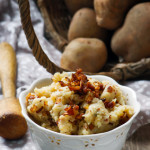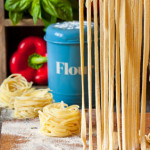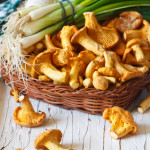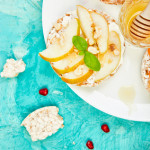The fruit that is available in the autumn isn’t nearly as abundant as the fruit that’s available in the summer, but there are actually some delicious seasonal autumn fruits that you can look forward to eating. Delicious, tasty, and healthy seasonal autumn fruit is also a refreshing alternative to the heavier food we tend to eat in the colder months. If you love fruit and have been missing summer’s bounty, there are plenty of autumn fruits that will satisfy your craving.
Apples are one of the quintessential autumn fruits. Every fall you will see crates full of apples at farmers’ markets. Try venturing out and get some of the lesser known varieties of apples. Each variety tastes very different and autumn is the perfect time to try all of the different varieties.
Pears are best in autumn even though you can get them year-round. In fall they make a great snack. Like apples, there are many different varieties of pears. Try as many different varieties as you can.
Pomegranates are so delicious because they’re the right combination of tart and sweet. The best pomegranates start being available in late October and early November, which means you must wait for most of autumn for them to be available.
Cranberries are not a fruit that most people think of eating. In fact, cranberries usually only make an appearance as cranberry sauce or jelly. However, there are actually other uses for this tart fruit. They make excellent smoothies when blended with oranges and bananas. Cranberries also taste great when roasted along with vegetables because they add a nice tart bite.
Grapes are a fruit that people eat by the handful. They’re delicious, and they make a nice healthy snack that children and adults love. If you have a chance, try some concord grapes this fall. They are a nice treat and a change from the globe grapes that we always find in the market.
Figs start making an appearance in grocery stores in early fall. They can be expensive, but they’re worth it. They have a wonderful sweet flavor that’s not too intense. Figs do have delicate skin so if you do buy them, make sure you plan on eating them right away.
Persimmons are a sweet fruit, but when you get persimmons you should make sure they’re fully ripe before eating them. Unripe persimmons are very astringent. Make sure they are plump and juicy before taking a bite.
“Work With What You Got!”
©Tiny New York Kitchen © 2019 All Rights Reserved
Turkey is the center of attention at the Thanksgiving table, but the sides are just as important.
Tips to make every experience in the kitchen successful!
1. Set up your workspace by gathering clean tools, bowls, and utensils. Make sure to keep a trashcan within reach.
2. To create an egg wash, whisk together a large egg with one tablespoon of water until smooth. Use as a glue to seal pastries, then brush on top for a glossy appearance.
3. Peel tomatoes with ease by cutting an X in the top, and then simmer in a pot of hot water for 15 to 30 seconds. Cool down and the skin will fall right off.
4. Get comfortable. Wear comfortable clothes and an apron when you work in the kitchen and you won’t have to worry about getting dirty.
5. Invest in a baking scale. Scales are not only an accurate way to measure your cooking ingredients, but they streamline the entire process.
6. Always read and re-read your recipes before you start cooking.
7. Clean as you go.
8. Use 2 skewers instead of 1 when grilling or roasting to prevent your food from spinning.
9. Learn to practice the rule of thumb to check the readiness of steak.
10. To prevent butter from over-browning in your pan, add a little bit of lemon juice.
11. Embrace salt. Don’t be afraid to use salt. It pulls the flavors out of your dishes. Cook with kosher salt and season with sea salt.
12. No luck finding shallots? Replace with a combination of onions and garlic.
13. After handling garlic, rub your fingers on stainless steel, like your skink, to get rid of the odor.
14. Ovens can lie. Place a second thermometer in your oven to ensure proper preheating temperatures.
15. Ignore cooking times. Check your dishes by using your own senses (smell, taste, touch) to decide when they are done.
16. The most versatile and important tool is a sharp chef’s knife.
17. Learn all the different ways to cook an egg.
18. When poaching an egg, add a teaspoon of white vinegar to simmering water to help keep the yolk from breaking.
19. For a great hardboiled egg every time, bring your pot to a boil and then turn off the heat. Let your eggs sit in the heated pot for 12 minutes and then transfer to cold water.
20. Crack eggs on a paper towel on the counter (no shells and makes for easy cleanup.
21. Make an ideal sunny-side egg by covering your pan with a lid and letting the steam cook your egg. No flipping required.
22. Always taste your food before seasoning.
23. Anchor your cutting board to the counter with a damp paper towel to keep things steady and safe. You could also use a dish towel instead of a paper towel.
24. Hold a knife properly. Pinch the blade instead of gripping the handle.
25. Don’t rinse pasta.
26. Substitute half a lemon and half an orange as a replacement for a Meyer lemon.
27. When sautéing garlic, use sliced garlic instead of minced to prevent burning.
28. Invest in a seasoned cast iron skillet. This kitchen staple distributes heat evenly and is easy to clean.
29. Remove tough stems on leafy greens by pinching the stem and gently pulling off the leaves with your other hand.
30. If your recipe calls for buttermilk, you can use regular milk with lemon juice.
31. Prepping salad before serving is a huge time saver. Layer all the ingredients in a bowl and don’t add the dressing when it’s time to serve.
32. Keep your spices away from sources of heat like the stove or lights. Herbs and spices can lose their flavor when exposed to humidity and heat.
33. Save old, stale bread to make breadcrumbs in a food processor. You can freeze them for up to 6 months.
34. Let steaks come to room temperature before seasoning and grilling.
35. Store fresh herbs in a glass of water in your refrigerator.
36. To prevent tears, cut off the root of the onion before you slice.
37. For crispy fries or chips; slice the potato, then remove the starch by soaking in water for one hour before baking.
38. Celery getting floppy? Try wrapping it in aluminum foil before storing in the refrigerator.
39. Soften hard brown sugar by placing a piece of dry bread in the bag overnight.
40. Roll citrus on the counter using the palm of your hand to help release all of the juice pockets.
41. -50. Kitchen Pantry Essentials: Olive Oil, Flour, Broth, Salt, Brown Rice or Pasta, Beans, Vinegar, Sugar, Eggs, and Soy Sauce.
51. Increase the shelf life of a halved avocado by keeping the pit intact and placing it in your refrigerator.
52. To prevent sliced apples from browning, lightly squeeze lemon or lime juice on the pieces.
53. You can store butter in the freezer for up to 6 months.
54. Honey is a natural preservative and will never spoil.
55. To last longer, opened flour bags can be stored in the freezer.
56. Mushrooms should be kept dry, as they can easily soak and store water.
57. Never overcrowd your skillet with food. The heat will not distribute evenly.
58. Use an egg slicer to cut small fruits like kiwis.
59. Recipes are only a guideline. Feel free to substitute items that cater to your personal preferences.
60. To rehydrate sun-dried tomatoes, soak them in hot water or stock for about 20 minutes.
61. The basic ratio to make a classic vinaigrette is 3 parts oil to 1 part vinegar.
62. To keep garlic from going rancid, always store it at room temperature.
63. Keep knives sharp by using a sharpening tool frequently. A sharp knife is important for safety and efficiency.
64. Purchasing and preparing a whole chicken is cost-effective and resourceful.
65. Honey stuck in a jar? Place the container in hot water for about 5 minutes to loosen up the sticky residue.
66. Safely chop odd-shaped vegetables by cutting off both ends for an even surface.
67. Create simple syrup by simmering 1 cup of water and 1 cup of sugar in a medium heated pot until the sugar dissolves. Bottle and store in the refrigerator for up to 2 weeks.
68. Freeze leftover tomato paste in small ice cube containers.
69. To soften butter, cut slices into a bowl and let sit at room temperature for 10 to 15 minutes.
70. When serving ice cream to large groups, ditch the ice cream scoop. Break oven the whole container and slice the ice cream into portions.
71. If you need to grate soft cheeses, freeze the cheese for 30 minutes for a cleaner slice.
72. A cutting tool called a mandolin can be your best friend. It allows you to perfectly julienne, slice, and dice vegetables every time. Always slice slowly and use the safety guard to prevent you from cutting your finger.
73. When sautéing, it is important to first heat the pan, then heat the oil, then add the ingredients.
74. Moisturize dried coconut by adding a sprinkle of milk and letting it sit for 10 minutes.
75. Prevent bacteria growth by cooling hot food in a shallow dish.
76. Make stock in large quantities and freeze in plastic bags for later use.
77. Use Greek yogurt as a healthy substitute for mayo, sour cream, heavy cream and more.
78. Before baking, remove butter and eggs from the refrigerator and let them reach room temperature.
79. Invest in high-quality extra virgin olive oil for special meals or to drizzle over dishes to accent flavors.
80. Let cooked or grilled meat rest at room temperature before serving.
81. Plunge vegetables in ice water after blanching to help maintain a bright color.
82. For easy clean-up, line baking sheets with parchment paper.
83. Save money by purchasing in-season fruit and vegetables. You can freeze and store in airtight containers to save for later.
84. Always taste your dishes before serving.
85. Never over-season seafood. You want to still be able to taste the flavor of the fish. Simply use lemon juice, salt, and pepper.
86. Look for ground beef that has been freshly ground.
87. To preserve flavor and prevent burning, it’s important to cook slow and keep your heat low.
88. Always measure when baking. Baking is a science and any wrong measurements can be disastrous.
89. Rice Cookers can be your personal kitchen assistants. Let them do all the tedious work and you will never worry about monitory and watching boil.
90. To make leafy greens last longer, wrap them in damp paper towels and place in a sealable plastic bag before storing.
91. Test oil in a pan before adding all of your ingredients. Throw a small piece in and make sure it sizzles before adding the rest.
92. When cooking with chile peppers, protect your hands and eyes by wearing rubber gloves. Or coat your hands in vegetable oil and wash them with soap and water immediately after handling.
93. Homemade meals are good for the heart and soul. Cook often and cook with others.
94. To prevent sogginess, do not dress salads for large parties. Serve, then allow guests to add their own dressing.
95. Seafood should never smell overwhelmingly fishy; that’s a sure sign that it’s starting to go bad.
96. Chill cookie dough before putting it on a baking sheet. This will help prevent your butter from flattening and losing its fluffy texture.
97. Remove seeds from chile peppers to help reduce heat.
98. Keep key kitchen appliances, like a blender, on your countertop to encourage frequent use.
99. Overcooked vegetables lose important enzymes and nutrients.
100. Disinfect wood cutting boards by hand washing with vinegar.
101. Always keep it simple and work with what you got!
“Work With What You Got!”
©Tiny New York Kitchen © 2019 All Rights Reserved
When the weather turns chilly, it’s time to pull out the slow cooker. From hot breakfasts to family dinners and show stopping desserts, using your slow cooker is easy and versatile.
“Work With What You Got!”
©Tiny New York Kitchen © 2019 All Rights Reserved
Turn out amazing treats with these easy tips and tricks to help you bake your best every time.
Measure Flour Accurately
Using a measuring cup to scoop directly from the bag can pack in too much flour, leading to dry, dense baked goods. Use the “spoon and sweep” method by gently stirring the flour in the bag with a spoon. Spoon the flour into your measuring cup. With the back of a knife, level off the cup and sweep the excess back into the bag.
Warm Eggs To Room Temperature
Room temperature eggs blend more easily in batter and dough, and whites whip up with bigger volume. Take eggs out of the refrigerator a couple hours before baking or add cold eggs to a large-size bowl. Cover with warm, not hot, tap water. Rest for 5 to 7 minutes while you measure other ingredients.
Test Your Baking Soda And Baking Powder
These leaveners help baked goods rise. If they aren’t active, quick breads and pancakes will be flat instead of fluffy. Spoon baking powder and baking soda into separate small bowls. Pour boiling water into baking powder. Pour distilled white vinegar into baking soda. If the ingredients fizz, they’re still active.
Measure Liquid And Dry Ingredients Separately
Too much or too little liquid can change the texture and taste of the finished recipe. Liquid measuring cups give you room to pour right up to the fill line without spilling. Use clear measuring cups with pour spouts for liquids. Use flat-bottomed measuring cups for dry ingredients and use the “spoon and sweep method.”
Prevent Overbaking
Know your oven’s quirks. All ovens run slightly differently, and some spots are hotter than others. Keep an eye on how your baked goods are browning, the temperature, and the time to make the best estimate. Use an oven thermometer to see if your oven runs hot or cold (a few degrees above or below what the dial says), and adjust accordingly. Set a kitchen timer, and check for doneness a few minutes early. Rotate your pan halfway through for even baking.
“Work With What You Got!”
©Tiny New York Kitchen © 2019 All Rights Reserved
There are a few pasta cooking rules that are important to memorize and you’ll have perfect pasta every time.
Boil your noodles in well-salted water, save that pasta liquid to make the glossiest pan sauce, do not rinse cooked pasta, and always pass extra grated parmesan cheese at the table.
“Work With What You Got!”
©Tiny New York Kitchen © 2019 All Rights Reserved
The fall season is a mixture of hot and cool, leaves changing and schedules becoming more structured. Whether you’re watching your child’s soccer game, taking a long weekend drive through winding roads saturated with fresh foliage or baking up the bounty of the season – take a moment to enjoy every phase the season has to offer.
“Work With What You Got!”
©Tiny New York Kitchen © 2019 All Rights Reserved
Kombucha is a tart, fizzy, fermented beverage made of sweetened tea and a specific culture known as a SCOBY (symbiotic culture of bacteria and yeast). It has been around for thousands of years. Kombucha’s probiotic content is what has everyone’s attention. The fermentation process also creates some vitamins, including vitamin C and certain B vitamins, and tea naturally contains antioxidants. However, there’s not hard scientific evidence to confirm the various health benefits that have been associated with probiotics. Not yet, at least. Enjoy Kombuchas as an alternative to sugary soft drinks, one with a possible probiotic, and nutrient boost. Too much Kombucha, however, could mean excess caffeine and sugar, not to mention that it’s a carbonated product and that could cause digestive issues when drinking high amounts. Most bottles contain two servings, so check the label and stick to 8 ounces or less at a time.
www.tinynewyorkkitchen.com
“Work With What You Got!”
©Tiny New York Kitchen © 2019 All Rights Reserved
Mushrooms should be evenly colored, feel firm and plump, and have a fresh, earthy smell. Avoid any mushrooms that are bruised or broken.
Keep packaged mushrooms in their original wrapping until ready to use. Store loose mushrooms in a paper (NOT plastic) bag to allow air to circulate.
Mushrooms trap dirt, so a good cleaning is key. Wait to clean mushrooms until ready to use. Mushrooms are like sponges. A quick rinse is ok, but it’s best not to soak them. If you do rinse mushrooms, dry them thoroughly with a kitchen towel to ensure proper browning. Instead of washing them you may use a damp paper towel or soft brush to wipe mushrooms clean.
In addition to being low in fat and sodium, mushrooms provide fiber. Mushrooms are one of the few natural food sources of vitamin D.
“Work With What You Got!”
©Tiny New York Kitchen © 2019 All Rights Reserved
Healthy snacks give your family the energy and nutrients they need throughout the day. As you plan snacks, think of them as “mini meals” that include two of the four food groups.
Try these simple nutritious snack ideas:
1. Whole grain crackers with a cheese stick
2. Fresh cut fruit with a yogurt dip
3. Nut-free trail mix. Mix dried cranberries, raisins, dried apricots, and apple rings with sunflower and pumpkin seeds, along with your family’s favorite cold cereal.
4. A small tortilla wrap spread with Greek yogurt, some jam and a banana.
5. A smoothie made with vanilla yogurt, blueberries, apples and some orange juice.
6. Vegetable sticks (like cucumbers and carrots) dipped in hummus.
Make snacks interesting by using a variety of shapes, colors, and textures.
• Offer different types of cheese (mozzarella, cheddar, Jack, Swiss) in different forms (cubes, strings, slices, and balls)
• Switch up the vegetables and fruit. Make sure you have a colorful variety in the fridge to choose from.
• Kids love to dip. Use cottage cheese, hummus, yogurt, or guacamole as healthy dips.
From planning to packing, get everyone in the family involved when making snacks. Take children grocery shopping and let them choose some of their favorite foods like breads, vegetables, fruit, and yogurts. Set aside time in the evening to pack lunches and snacks. You’ll be happy you did during the next day’s busy morning rush!
Food Allergies: Schools have different policies when it comes to food allergies. Many schools have a nut-free policy throughout the whole school, and some have policies just for some classrooms. Find out about the food allergy policy at your child’s school. Once you know about the foods that need to be avoided, keep them in mind when reading the ingredient list on food labels and when packing lunches.
Back to school snacks can be nutritious and delicious. With a little planning and creativity, your kids will love snack time at school.
“Work With What You Got!”
©Tiny New York Kitchen © 2019 All Rights Reserved















